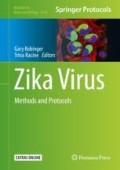Abstract
Zika virus (ZIKV) is an important pathogen transmitted to humans by the mosquito vector Aedes aegypti. ZIKV is able to infect several tissues and organs and, importantly, has been associated with microcephaly and central nervous system abnormalities in fetuses and newborn babies of mothers exposed to ZIKV during pregnancy, as well as neurological diseases such as Guillain-Barré syndrome in adults. There is currently no vaccine or drug licensed to prevent or treat ZIKV infections. The use of ZIKV isolation in disease diagnosis has been largely replaced by new techniques. However, virus isolation is still considered as a gold standard for the detection of ZIKV and is usually performed in research and reference laboratories for characterization, sequencing, and a variety of research experiments including pathogenesis, drug susceptibility, and vaccine efficacy. The experimental procedures presented here describe the most common techniques used for ZIKV isolation, propagation, purification, and quantification.
Access this chapter
Tax calculation will be finalised at checkout
Purchases are for personal use only
References
Smithburn KC (1952) Neutralizing antibodies against certain recently isolated viruses in the sera of human beings residing in East Africa. J Immunol 69:223–234
Simpson DI (1964) Zika virus infection in man. Trans R Soc Trop Med Hyg 58:335–338
Duffy MR, Chen TH, Hancock WT et al (2009) Zika virus outbreak on Yap Island, Federated States of Micronesia. N Engl J Med 360:2536–2543
Musso D, Bossin H, Mallet HP et al (2018) Zika virus in French Polynesia 2013-14: anatomy of a completed outbreak. Lancet Infect Dis 18:e172–e182
Zanluca C, Melo VC, Mosimann AL, Santos GI, Santos CN, Luz K (2015) First report of autochthonous transmission of Zika virus in Brazil. Mem Inst Oswaldo Cruz 110:569–572
WHO (2019) Zika: the continuing threat. Bull World Health Organ 97:6–7. Available at https://www.who.int/bulletin/volumes/97/1/19-020119/en/
Hirsch AJ, Smith JL, Haese NN et al (2017) Zika virus infection of rhesus macaques leads to viral persistence in multiple tissues. PLoS Pathog 13:e1006219
Miner JJ, Diamond MS (2017) Zika virus pathogenesis and tissue tropism. Cell Host Microbe 21:134–142
Oehler E, Watrin L, Larre P, et al. (2014) Zika virus infection complicated by Guillain-Barre syndrome—case report, French Polynesia, December 2013, Euro Surveill 19(9): pii: 20720
Rasmussen SA, Jamieson DJ, Honein MA, Petersen LR (2016) Zika virus and birth defects—reviewing the evidence for causality. N Engl J Med 374:1981–1987
Himmelsbach K, Hildt E (2018) Identification of various cell culture models for the study of Zika virus. World J Virol 7:10–20
Donaldson CD, Bishop KN (2015) Cell culture. Br J Hosp Med (Lond) 76:C2–C5
Reed L, Muench H (1938) A simple method of estimating fifty percent endpoints. Am J Hyg 27:493–497
Author information
Authors and Affiliations
Corresponding author
Editor information
Editors and Affiliations
Rights and permissions
Copyright information
© 2020 Springer Science+Business Media, LLC, part of Springer Nature
About this protocol
Cite this protocol
Baz, M. (2020). Zika Virus Isolation, Purification, and Titration. In: Kobinger, G., Racine, T. (eds) Zika Virus. Methods in Molecular Biology, vol 2142. Humana, New York, NY. https://doi.org/10.1007/978-1-0716-0581-3_2
Download citation
DOI: https://doi.org/10.1007/978-1-0716-0581-3_2
Published:
Publisher Name: Humana, New York, NY
Print ISBN: 978-1-0716-0580-6
Online ISBN: 978-1-0716-0581-3
eBook Packages: Springer Protocols

